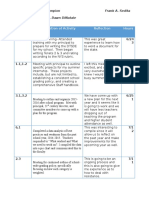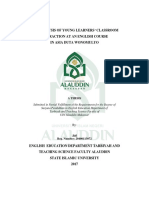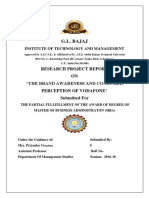Professional Documents
Culture Documents
Women As A Valuable Asset Eng
Uploaded by
Rita AzevedoOriginal Title
Copyright
Available Formats
Share this document
Did you find this document useful?
Is this content inappropriate?
Report this DocumentCopyright:
Available Formats
Women As A Valuable Asset Eng
Uploaded by
Rita AzevedoCopyright:
Available Formats
Women as a Valuable Asset
Women in governing positions positively influence the companys performance. Organizations that timely take appropriate measures and help talented women climb up the corporate ladder will gain a decisive competitive edge.
Darya Borisova Olga Sterkhova
Women as a Valuable Asset
Introduction
No matter how paradoxical it may seem, there is a positive correlation between theproportion of women in the top management and the organizational and financial performance of the companies. A study conducted by McKinsey shows that companies having women among top managers demonstrate higher operating margin and market capitalization in the industry than companies managed by men only. However, women are considerably under-represented in the senior management ofcompanies all over the world and the trend for positive changes in the gender gap isalmost non-existent. This becomes evident when we compare the results ofMcKinseys studies from the series Women Matter published in 2007 (analysis oftop management gender composition in 50 leading listed companies from 13 European countries) and in 2010 (compositional analysis of corporate boards and executive committees of large companies from six European countries and BRIC countries). However, in some countries the proportion of women in companies management is growing, although insignificantly. France is leading the trend the share of women in the executive committees grew there by 7% from 2007 to 2010. In the majority ofother countries, the growth rate varies in the range of 03%. On the whole, there are different levels of gender diversity in companies top management in different regions. Women are best represented in the top management of Nordic companies (which to agreat extent is caused by the current gender quotas): in Norway women make 32% ofexecutive committees, in Sweden 27% (for comparison, in UK the corresponding share is 12%, in Russia 8%). The average proportion of women in corporate boards is even smaller 17% and 12% in Sweden and Norway respectively, 11% in Russia, and 2% in Germany (see box Share of Women in Companies Management on page 4). The number of women in the top management also varies depending on the industry. For instance, women are relatively well represented both in executive committees (16%) and in the corporate boards (12%) in the segment of retail trade and consumer goods, while insuch sectors as transportation, logistics, real estate and construction their proportion isnoticeably lower: 69% in executive committees and 89% in corporate boards. Executives of many organizations are coming to understand that gender diversity inbusiness management is crucial for achieving high performance. However, ensuring gender diversity in the top management very rarely becomes a strategic priority ofacompany. Meanwhile, unless comprehensive measures aimed at increasing theproportion of women in the top management are taken, the situation will not improve. Based on the data of McKinsey studies we will tell you what prevents women from climbing up the corporate ladder and how to develop an efficient system ensuring gender diversity.
Share of Women in Companies Management Percent
Proportion of women in boards of directors Analysis of the composition of governing bodies of 441 companies from six European countries, BRIC countries and the USA, conducted by McKinsey in 2010, showed that the number of women holding governing positions was still lower than that of men. The greatest gender diversity was registered in the companies of the Nordic countries, and the lowest gender diversity in BRIC countries. Russia has fewer women in executive committees than Europe or the USA, but more than BRIC countries in general. At the same time, the proportion of women in boards of Russian companies is even higher than in boards of companies from certain European countries. To a certain degree it may be explained by the principles of gender parity applied during Soviet times. Norway Sweden USA France Germany Great Britain Spain Russia Brazil China India 8 7 6 5 2 6 8 15 15 13 12 10 6 11 2 14 7 27 14 32 Proportion of women in corporate boards 12 17
SOURCE: McKinseys proprietary database, 2010; Catalyst, 2009; The Female FTSE Board Report 2009, Cranfield University.
Women as a Valuable Asset
Women in Management Mean Companys Success
Various data confirm the connection between the organizational and financial performance of the companies and the presence of women in the top management. Among such data are the results of the study conducted by McKinsey based on two largescale surveys. The first survey was dedicated to assessment of the influence exerted byfemale managers on the effectiveness of the organizational model of thecompany, and the second survey determined whether there was a correlation between the presence of female top managers and the financial performance of thecompany. During the first survey the specialists examined 231 firms in order to measure theorganizational excellence of each firm against the nine criteria: leadership, direction, accountability, coordination and control, innovation, external orientation, capability, motivation, work environment and values. It turned out that there is a direct correlation between the level ofthe organizational effectiveness of the company and its financial Idea in a Nutshell performance. The companies Companies where governing positions ranked most highly according are held both by men and by women have tothese organizational criteria higher operating margin and market tended to have operating margin capitalization in the respective industry. and market capitalization twice ashigh as those of the lowestranked companies. Women and men tend to apply different leadership behaviors, and only combination Then the researchers selected of the most effective leadership behaviors 101 companies that publish makes it possible to increase the company thecomposition of their governing value. Therefore ensuring gender bodies out of the previously diversity in top management should examined ones. After surveying become a strategic priority for every 58,240 employees, they found organization. In order to allow women to out that companies with three pursue professional development and or more women in senior successfully combine work and family life, management scored more highly smoothly climbing up the career ladder, it for each organizational excellence is necessary to create favorable conditions criterion than companies with no both on state and corporate level. The women at the top. It is notable authors of the article tell us which measures that performance increases should be taken in the first place. significantly once a certain critical mass is attained: at least three women in a corporate board. The correlation between the organizational model excellence and the participation of women in management bodies echoes a number of comments made by CEOs of arious organizations. For instance, a board member of a major banking group says the following: When women sit on an executive committee, the nature of interaction changes. But, one woman there is not enough, you need several of them. And the vice president of the European division of a leading global pharmaceutical company has
thefollowing to say: I think the real benefit of having women and diversity in a team isthat you have a richer set of ideas. So, I truly believe there is a direct relationship between team performance and having a diverse team with the best talents. During the second survey McKinsey specialists analyzed financial performance of362 major companies from European and BRIC countries with two or more women inthecorporate board. As a result they found out that on the whole such companies are 41% ahead of the sectors average in terms of return on equity and 56% ahead in terms ofEBIT (see box Corporate Financial Performance and Women in Top Management). Despite the fact that statistical surveys, strictly speaking, do not identify cause and effect relationships, they confirm the thesis about advantages of womens presence in the companies top management. The rightness of this thesis is also confirmed bythe comments made by top managers: the majority of them believe that balanced participation of men and women in the management has a positive influence onthecompanys performance. 62% of male respondents and 90% offemale respondents including chief executive officers, chief operating officers, chief financial officers, etc. note a positive correlation between the number ofwomen in the companys management and its financial performance.
Corporate Financial Performance and Women in Top Management
Using a proprietary database (covering the UK, France, Germany, Spain, Sweden, Norway and BRIC countries) McKinsey specialists defined which companies in different industries belong to the upper quartile in terms of the relative number of women in top management. Then in each industry, the financial performance of companies of the upper quartile was compared to the performance of companies having no women in top management. It turned out that the companies with the highest number of women in top management had the best performance.
Companies having no women in top management Companies with the highest proportion of women in top management
Average return on equity Percent
Average EBIT margin Percent
15
+41%
22
11
+56%
17
Women as a Valuable Asset
Complementary Leadership Behaviors
In order to define what causes a positive correlation between the proportion of women in the top management and organizational and financial performance of the companies, McKinsey conducted a survey of approximately 800 executives of companies from different countries in 2009. It turned out that certain leadership behaviors that allow companies to achieve success in the post-crisis environment are typical of men, while the other leadership behaviors are more characteristic of women. And only acombination of different leadership behaviors contributes to balanced development of a company. The researchers identified nine key leadership behaviors that improve themanagerial excellence: Participative decision making building a team atmosphere in which everyone is encouraged to participate in decision making; Role model an ability to be a role model; Inspiration presenting a compelling vision of the future business development and inspiring optimism in the employees; Expectations and rewards defining expectations and responsibilities clearly, recognizing the contribution of employees and rewarding achievement of target; People development mentoring and listening to individual needs and concerns; Intellectual stimulation encouraging initiative, risk taking and creativity; Efficient communication communicating in a convincing way, with charisma; Individualistic decision making preferring to make decisions alone and engaging others in executing them; Control and corrective action monitoring individuals performance against objectives, and taking corrective action when needed. Having analyzed how often these leadership behaviors are applied by men and women, researchers found that three of the nine above listed behaviors (People development, Expectations and rewards, and Role model) are more typical of female managers. Men prefer such leadership behaviors as Control and corrective action and Individualistic decision making. Such leadership behaviors as Inspiration, Efficient communication, Participative decision making, and Intellectual stimulation present no significant differencesintheirfrequency of use between women and men. Almost a half (48%) of the survey participants believe that Inspiration is the most important leadership behavior. Moreover, 45% of the respondents are convinced that this leadership behavior plays the key role in achieving high business performance.
Intheir turn, 47% of the respondents think that the behavior Expectations and rewards is critical for performance management. Given this, it is notable, that according to many respondents, the list of the most frequently used leadership behaviors is headed by Control and corrective action. According to 38% of top managers, it started to be most frequently used in their company upon the beginning of the crisis. Domination of any leadership behavior however useful it might be for an organization should be restricted so that it does not prevent development of other leadership behaviors, more targeted at motivation and inspiration of employees, at mentoring andencouraging creative thinking. Increasing the share of women in management is one of effective tools for creation of a balanced management model based on application ofdifferent leadership behaviors.
Women as a Valuable Asset
Barriers to Success
So what prevents women from becoming top-managers? In order to identify thekey career barriers for women we collected the data of several European andNorth-American studies from different years and surveyed over 50 executives of different European countries. The majority of the surveyed executives, both men and women, believe that the career development is mostly influenced by the factors related toworking environment (89% of respondents) and their own aspirations (79% of respondents). At the same time, family concerns turned out to be of lower importance both for women (42%) and men (49%) regardless of whether they had children. Besides, 89% of the respondents noted that they did not regret their decision to develop their career on the contrary, they believed that this decision had positively influenced their intellectual development and material standing. Still, many women believe that top governing positions are almost unattainable for them. The survey of 445 executives, both men and women, that took place within McKinseys study of 2010, as well as numerous interviews with female top managers allow us to identify a number of key factors hindering strengthening ofwomens positions in companies.
The double burden
The necessity to combine work and domestic responsibilities creates asignificant pressure on women and makes them face a difficult choice. Thewoman remains at the center of family life in the modern society: she brings up children, is responsible for housekeeping, and cares for the elderly. Such family workload may vary depending on the availability of such infrastructures as day nurseries, kindergartens, etc. On the average, European women devote twice as much time as men to domestic tasks: 4 hours and 29 minutes a day, compared with 2 hours and 18 minutes for the men. In most countries family and children are considered a barrier to womens career development. In France for instance, 96% of female graduates from elite universities of the country believe that having children or simply being ofchildbearing age is a real barrier when applying for a job. In Russia, 54% ofwomen mentioned family as one of the factors negatively affecting their careers. Besides, over 80% of Russian women with children younger than 14 choose most often for economic reasons a life strategy of a working mother: they combine work and family duties. For comparison, in European countries theshare of women following this strategy is below 70% (in Russia by no means all women who want to work have jobs; i. e. the existing potential is not leveraged in full). We would like to underline that comments made by Russian women oncombining work and children upbringing demonstrate an evident trend it is believed that children of preschool age hinder the professional fulfillment more that schoolchildren.
10
The necessity to work anytime, anywhere
Corporate cultures of many companies are dominated by a behavioral model assuming that top managers should be unfailingly available and ready for unplanned frequent business trips. Women believe that such requirements are incompatible with the double burden. For example, in the USA, 62% of women perceive family obligations and reduced mobility as an obstacle to their promotion.
Excessive modesty, lack of ability to promote oneself
The business model adopted by most companies of the world requires persistence in asserting ones professional interests. This includes, among others, an ability to promote oneself and assert ones talents. Women tend to underestimate their talents and achievements. A board member of a major banking group comments: On the same project, the men will demonstrate 100% ambition even if they only have 50% of the required skills, whereas the women will be concerned about only having 80% of the required skills. This observation is backed by a survey of MBA students: 70% of female respondents rate their own performance as equivalent to that of their co-workers, while 70% of men rate themselves higher than their co-workers. Women understand that the ability to play by the mens rules is a critical condition of career development, and try to adjust to such requirement and develop their own fighting qualities, become more assertive defending their interests. However, changing the value system is a challenge for them. Thats why women often lose inthe situations when promotion of ones talents and capabilities is required and less often gain recognition in the company in other words, they less frequently capture every opportunity for promotion.
Absence of role models
Over a half of the female respondents (61%) consider the absence of worthy role models to be a barrier for their professional development (this opinion is shared just by 31% of the male respondents). Only clearly evident measures allow women tobelieve in the possibility of professional success and career development without affecting the family life. According to the chairwoman of a media group who often meets students, the first question she is always asked by female students is how she manages to balance her private and professional life. Female employees of many European and American companies as well as of some Russian companies consider another key problem to be the absence of a mentor an experienced senior colleague who helps junior specialists solve tasks, teaches them and supports them with advice, acting as a role model. According to a Catalyst study, only 33% of women (and 42% of men) have no difficulties finding a mentor.
Women as a Valuable Asset
11
There are other obstacles preventing women from climbing up the corporate ladder. Such barriers include the lack of ability to establish and develop useful business links, the lack of a state family policy and a system for social support of families, and lower ambitions compared to men. According to the survey performed by Sylvia Ann Hewlett, Carolyn Buck Luce and Peggy Schiller, authors of the article The Hidden Brain Drain Off Ramps and On Ramps in Womens Career (Harvard Business Review, March 2005), only 35% of women (and 48% of men) see themselves as extremely or very ambitious. In addition, only 15% ofhighly qualified women (against 27% of men) aspire to positions of power. Women expect less from their careers than men; to a great extent it is caused by their great awareness of the barriers. In France for instance, 77% of women (and 49% of men) believe that there are numerous barriers hindering their career development. According to McKinseys study, such barriers often force women to decline senior positions. It is characteristic that it often negatively affects their future career. A head of marketing in aFrench subsidiary of a major European bank says: When, for personal reasons, I declined the top job in an overseas branch, I was told I was excluding myself from the system. It was seen as career suicide. A voluntary decision to discontinue ones career is both the evidence (and result) ofthehigh barriers and an additional cause of the shortfall of women in corporate executive bodies. In the USA, 37% of female participants of the survey conducted bySylvia Ann Hewlett, Carolyn Buck Luce and Peggy Schiller voluntarily stopped working at some point in their career, against just 24% of men. One of the main reasons for opting out put forward by these women was the need to spend more time with their family (45% of the respondents). If the career is discontinued due to a maternity leave, thebarriers grow: out of the 93% ofwomen who have taken career breaks and intended to get back to work, only 74% have managed to do so, and only 40% have found full-time work. The study also brought to light the significant differences between men and women in two aspects. In the first place, 27% of women (versus just 7% of men) admitted that they had felt discriminated against due to their gender during their professional career. In thesecond place, there was a substantial demographic difference between the male and female respondents: 54% of women (versus just 29% of men) were childless, and 33% ofwomen (and 18% of men) were single. Another survey performed by Sylvia Ann Hewlett confirmed that the higher women climb up the corporate ladder, the fewer children they have, whereas the reverse is true for men. Forexample, in the 4155 age range, 49% of the best paid women (over USD 100 thousand a year) are childless, while only 19% of the best paid men are childless. Thefigure for the well paid women (USD 5565 thousand a year) is 33% (compared to25% of men). As the business is still dominated by a male-centric model of corporate behavior, women who carve out prime positions for themselves today follow the same path as men: put career before family and pay a higher price for professional success. And this is one ofthe key barriers preventing achievement of gender diversity in companies management.
12
Attracting and Retaining Women
Contrary to the established opinion, an increase of female university graduates almost does not change the gender balance in companies management. According to McKinseys estimates, for example, while the share of women with university education level increased from 32% to 55% in 19702000s in Germany, the proportion of women in top management grew from 2% to just 4%. In France, the increase in thenumber ofemale university graduates from 41% to 55% during the same period was accompanied by growth of the number of women in top management from 7% to9%. In Russia, the share of women employees with university degree amounted to 54% in2009; however, this fact does not mean that women dominate top management. In order to allow women to pursue professional development and successfully combine work and family life, smoothly climbing up the career ladder, it is necessary to create favorable conditions both on state and corporate level. The priorities of the state initiatives may vary. For example, although France and the UK have similar employment rates for women (60% and 67% respectively), these countries apply different measures aimed at gender diversity. In France, there are many social services aimed at family support, therefore French women have a certain advantage in terms of combining family and professional life as compared to British women. In the UK, state childcare support initiatives are just starting to develop, but there is a strong tradition of workplace equality contrary to France, where it is very difficult to achieve equality in the workplace. Russia should take measures in the both directions: formalize the gender parity inlegislation and promote it, as well as develop the system of state social support, using the capacities created during the Soviet times and improving the infrastructure quality (kindergartens, day-care centers, etc.). As for the corporate initiatives, their range is rather extensive. Some companies have already begun to purposefully develop measures aimed at attraction, promotion and retention of talented female employees. But despite the fact that women are actively fighting for their business rights in developed countries, the situation is changing very slowly. The studies conducted by McKinsey specialists allowed us to identify the most effective measures aimed at development of women and ensuring gender diversity in companies, and to divide these measures into three groups. An active position of the companys CEO. Implementation of gender diversity principles can be similar to a revolution in the corporate culture of the organization. Therefore the CEO of the company should promote gender parity and perform the necessary changes. Introduction of progressive methods will not bring the desired results unless every top manager contributes to the transformation of the corporate culture. A close attention of all companys top managers to the results in this area and their participation in the implementation of initiatives aimed at ensuring gender diversity is the critical prerequisite for increasing the proportion of women in the management.
Women as a Valuable Asset
13
Individual programs of professional development. The main objective of such programs is to help women overcome the obstacles preventing them from climbing up the corporate ladder. Organizations that have achieved the best results in terms ofgender diversity apply efficient training and mentoring programs that allow the female employees to embrace their potential and to start actively and purposefully developing their career playing by the mens rules. These companies apply such tools as regular meetings of a womens club, virtual forums and other events that could help women establish contacts in the professional community. As young female employees often need a role model, it is advisable to connect them with a senior female colleague acting as a mentor. Comprehensive measures aimed at development of favorable conditions for working women. Such measures include, first of all, changes in the HR policies: recruitment, performance reviews and promotion. For instance, when developing apool of the most promising employees some companies include such career breaks as the maternity leave or the childcare leave in the length of service. Some firms have arule to include at least one woman into the candidate pool for any governing position. Some companies have recruitment programs targeted at women. Other effective measures aimed at development of favorable working conditions include a possibility to work from home, part-time, according to a flexible or an individual schedule. Theflexible approach remains one of the key factors providing for an optimal balance between the work and family and simplifying climbing up the corporate ladder. Aswomen have to make career breaks due to child births and childcare leaves, support from the company during such periods can mitigate the negative influence exerted by the breaks on the career development and the salary growth. A survey that McKinsey performed among its employees showed that its female employees believe that the most important measures aimed at ensuring gender diversity are the following: mentoring on part of female managers; targeted training programs; events aimed at establishing contacts in the professional community; working conditions that allow optimal distribution of time between work and family life. As the company actively applies the mentorship system, offers prolonged maternity leaves and allows working mothers to transfer to part-time jobs, the proportion of women in McKinsey & Company has been steadily growing. At the end of 2010, their total share in the company amounted to 21%, and in some offices of the company this proportion was even higher 22% in Russia and 30% in France. While many business leaders already understand that the presence of women in the top management of a company positively influences its performance and financial results,
14
only few of them take any measures to achieve gender diversity. Top managers do not believe that they could influence the state of affairs and are either poorly acquainted with mechanisms of supporting and promotion of women or do not understand such mechanisms at all. However, there are certain major companies, including the Russian ones, that have managed to include women in their top management. There are two women onSberbanks Board: Bella Zlatkis, Deputy Chairperson of the Management Board, andOlga Kanovich, Board member and Senior Vice President. VTBs Board also includes two women: Olga Dergunova and Ekaterina Petelina. ProfMedia, one ofthelargest media and entertainment businesses in Russia with leading positions inquality entertainment media, both the President and the Executive Vice President are women: Julia Solovieva and Olga Paskina. If companies start learning from experience of organizations that have managed to develop a corporate culture targeted at gender diversity and start timely taking measures to attract women to governing positions, they will be able to ensure a great competitive edge.
Women as a Valuable Asset
:
Darya Borisova Partner Moscow Darya_Borisova@mckinsey.com Olga Sterkhova Partner Moscow Olga_Sterkhova@mckinsey.com
April 2012 Copyright McKinsey & Company
www.mckinsey.ru
You might also like
- The Subtle Art of Not Giving a F*ck: A Counterintuitive Approach to Living a Good LifeFrom EverandThe Subtle Art of Not Giving a F*ck: A Counterintuitive Approach to Living a Good LifeRating: 4 out of 5 stars4/5 (5784)
- The Yellow House: A Memoir (2019 National Book Award Winner)From EverandThe Yellow House: A Memoir (2019 National Book Award Winner)Rating: 4 out of 5 stars4/5 (98)
- Never Split the Difference: Negotiating As If Your Life Depended On ItFrom EverandNever Split the Difference: Negotiating As If Your Life Depended On ItRating: 4.5 out of 5 stars4.5/5 (838)
- Shoe Dog: A Memoir by the Creator of NikeFrom EverandShoe Dog: A Memoir by the Creator of NikeRating: 4.5 out of 5 stars4.5/5 (537)
- The Emperor of All Maladies: A Biography of CancerFrom EverandThe Emperor of All Maladies: A Biography of CancerRating: 4.5 out of 5 stars4.5/5 (271)
- Hidden Figures: The American Dream and the Untold Story of the Black Women Mathematicians Who Helped Win the Space RaceFrom EverandHidden Figures: The American Dream and the Untold Story of the Black Women Mathematicians Who Helped Win the Space RaceRating: 4 out of 5 stars4/5 (890)
- The Little Book of Hygge: Danish Secrets to Happy LivingFrom EverandThe Little Book of Hygge: Danish Secrets to Happy LivingRating: 3.5 out of 5 stars3.5/5 (399)
- Team of Rivals: The Political Genius of Abraham LincolnFrom EverandTeam of Rivals: The Political Genius of Abraham LincolnRating: 4.5 out of 5 stars4.5/5 (234)
- Grit: The Power of Passion and PerseveranceFrom EverandGrit: The Power of Passion and PerseveranceRating: 4 out of 5 stars4/5 (587)
- Devil in the Grove: Thurgood Marshall, the Groveland Boys, and the Dawn of a New AmericaFrom EverandDevil in the Grove: Thurgood Marshall, the Groveland Boys, and the Dawn of a New AmericaRating: 4.5 out of 5 stars4.5/5 (265)
- A Heartbreaking Work Of Staggering Genius: A Memoir Based on a True StoryFrom EverandA Heartbreaking Work Of Staggering Genius: A Memoir Based on a True StoryRating: 3.5 out of 5 stars3.5/5 (231)
- On Fire: The (Burning) Case for a Green New DealFrom EverandOn Fire: The (Burning) Case for a Green New DealRating: 4 out of 5 stars4/5 (72)
- Elon Musk: Tesla, SpaceX, and the Quest for a Fantastic FutureFrom EverandElon Musk: Tesla, SpaceX, and the Quest for a Fantastic FutureRating: 4.5 out of 5 stars4.5/5 (474)
- The Hard Thing About Hard Things: Building a Business When There Are No Easy AnswersFrom EverandThe Hard Thing About Hard Things: Building a Business When There Are No Easy AnswersRating: 4.5 out of 5 stars4.5/5 (344)
- The Unwinding: An Inner History of the New AmericaFrom EverandThe Unwinding: An Inner History of the New AmericaRating: 4 out of 5 stars4/5 (45)
- The World Is Flat 3.0: A Brief History of the Twenty-first CenturyFrom EverandThe World Is Flat 3.0: A Brief History of the Twenty-first CenturyRating: 3.5 out of 5 stars3.5/5 (2219)
- The Gifts of Imperfection: Let Go of Who You Think You're Supposed to Be and Embrace Who You AreFrom EverandThe Gifts of Imperfection: Let Go of Who You Think You're Supposed to Be and Embrace Who You AreRating: 4 out of 5 stars4/5 (1090)
- The Sympathizer: A Novel (Pulitzer Prize for Fiction)From EverandThe Sympathizer: A Novel (Pulitzer Prize for Fiction)Rating: 4.5 out of 5 stars4.5/5 (119)
- Her Body and Other Parties: StoriesFrom EverandHer Body and Other Parties: StoriesRating: 4 out of 5 stars4/5 (821)
- Internship Daily Log 400 HoursDocument12 pagesInternship Daily Log 400 Hoursapi-323925631100% (2)
- Nickelodeon #KidsTogether Guide: Talking With Kids About CoronavirusDocument2 pagesNickelodeon #KidsTogether Guide: Talking With Kids About CoronavirusDerek E. BairdNo ratings yet
- Japan Doing Business in a Unique Culture (Bucknall, Kevin B. [Bucknall, Kevin B.]) (Z-Library)Document218 pagesJapan Doing Business in a Unique Culture (Bucknall, Kevin B. [Bucknall, Kevin B.]) (Z-Library)sparta151122No ratings yet
- Reflecting On The Lessons You Taught or Observed: 4. Plan Action 1. DescribeDocument2 pagesReflecting On The Lessons You Taught or Observed: 4. Plan Action 1. DescribeIsam MrahNo ratings yet
- Organizational DevelopmentDocument29 pagesOrganizational DevelopmentvaijayanthiNo ratings yet
- Psychology Lecture on Subject, Objectives and FieldsDocument5 pagesPsychology Lecture on Subject, Objectives and FieldsMaira456No ratings yet
- MODULE 6. Developmental Reading Topic 6. Comprehension - Theories and StrategiesDocument11 pagesMODULE 6. Developmental Reading Topic 6. Comprehension - Theories and StrategiesBeverly Panganiban CadacioNo ratings yet
- The Bartenders Field Manual Free Chapters 1 PDFDocument27 pagesThe Bartenders Field Manual Free Chapters 1 PDFLeivaditisNikos0% (2)
- Chapter 2Document20 pagesChapter 2Tahia Anjum100% (1)
- The Analysis of Young Learners Interaction at An English Course in Asia Duta WonomulyoDocument55 pagesThe Analysis of Young Learners Interaction at An English Course in Asia Duta WonomulyoazizahNo ratings yet
- What Is EgoDocument4 pagesWhat Is EgoHimanshu SinghNo ratings yet
- Two Kinds of Design May Be Identified in Ex Post Facto ResearchDocument5 pagesTwo Kinds of Design May Be Identified in Ex Post Facto ResearchMarie Glor Garais BallesterosNo ratings yet
- SC Judging The ValidityDocument30 pagesSC Judging The ValidityHycinth Vixen F. AlbanoNo ratings yet
- Learn Festivals Malaysia Speaking Writing SkillsDocument4 pagesLearn Festivals Malaysia Speaking Writing SkillssyajeffNo ratings yet
- TRAINING AND DEVELOPMENT SURVEYDocument32 pagesTRAINING AND DEVELOPMENT SURVEYKhushboo KhannaNo ratings yet
- Creative Economy PDFDocument39 pagesCreative Economy PDFMarco MallamaciNo ratings yet
- Introduction to Philosophy ResourcesDocument6 pagesIntroduction to Philosophy ResourcesMitakun UlfahNo ratings yet
- ASO Intern DescriptionDocument1 pageASO Intern DescriptionSheila BanuelosNo ratings yet
- Emotion Coaching Handout For ParentsDocument7 pagesEmotion Coaching Handout For Parentsrshann04100% (2)
- GL Bajaj FormateDocument5 pagesGL Bajaj FormateFARMANNo ratings yet
- Common Questions in InterviewDocument5 pagesCommon Questions in Interviewmanojpatil186No ratings yet
- The Human Rights ActDocument20 pagesThe Human Rights ActImprovingSupportNo ratings yet
- 05 N015 28867Document15 pages05 N015 28867Archana SahuNo ratings yet
- Potrayal of Women in CinemaDocument97 pagesPotrayal of Women in CinemaMitali Srivastava BhatnagarNo ratings yet
- Nouns PrepositionsDocument6 pagesNouns PrepositionsrodrigoNo ratings yet
- British Airways Recruitment StrategyDocument2 pagesBritish Airways Recruitment StrategyAbhishek Srivastava100% (1)
- Australian Digital ThesisDocument194 pagesAustralian Digital ThesisGinger KalaivaniNo ratings yet
- Module 8Document5 pagesModule 8api-507793249No ratings yet
- Chapter 2Document22 pagesChapter 2nurhani mohamadNo ratings yet
- Understanding SociologyDocument11 pagesUnderstanding SociologyheretostudyNo ratings yet











































![Japan Doing Business in a Unique Culture (Bucknall, Kevin B. [Bucknall, Kevin B.]) (Z-Library)](https://imgv2-1-f.scribdassets.com/img/document/721402476/149x198/886c54a86e/1712650374?v=1)


























